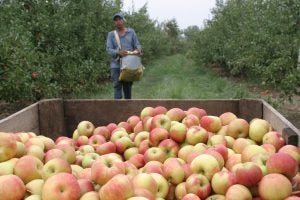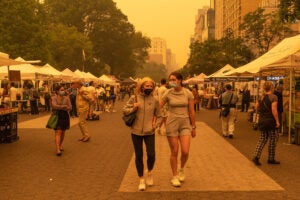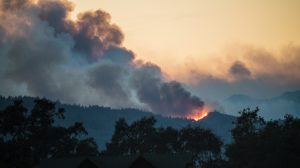Unless you’ve spent some time in Michigan over the warmer months, you might not realize that the state is a major producer of fruits and vegetables. This includes more than 40,000 acres of cherries, 38,000 acres of apples, and 22,000 acres of blueberries. As a result, Michigan is home to a number of roadside stands and farm markets selling fresh produce — an attraction that has a long and rich history in the Great Lakes state.
But no place is immune from modern problems, especially an industry so reliant on a changing climate. The smoke from Canadian wildfires that polluted the air across the Midwest during summer 2023 was a stark reminder. The question is how those changes, particularly continuing wildfire smoke, impacts specialized crops.
Michigan’s Fruit Belt
Lake Michigan largely influences Michigan’s weather patterns, especially along the state’s west side. The lake minimizes temperature fluctuations, which protects fruit trees from frost late in the spring and early in the fall. It also (mostly) experiences consistent rainfalls. The region possesses fertile soils and gently sloping fields. Altogether, these factors make west Michigan the perfect location to grow fruits common to the temperate zones. It’s why this swath of Michigan has been dubbed the Michigan Fruit Belt since the late 1800s.
Today you’ll still find an assortment of farm markets and roadside stands. There’s also a growing wine industry boasting of vintages made from Michigan-grown grapes. And if you time your travel correctly, you can enjoy a number of fruit-themed festivals in a number of small towns.

My family was part of this tradition. My great-grandparents and grandparents settled in the area in the 1950s. Their 200-acre farm produced apples, peaches, plums, and pears. They also grew cantaloupes. Most of the produce was sold at the Benton Harbor Fruit Market, which was established in 1860 and claimed to be the world’s largest market for fresh produce.
My parents eventually transitioned the farm to growing produce for our roadside stand. For over 25 years, we sold fresh produce directly to consumers continuing a popular tradition of the Michigan Fruit Belt. We were hardly the only such venue, and we sometimes sold surplus produce to those other roadside stands.
We closed our roadside stand over a decade ago for various reasons. Unfortunately, we’ve learned that more than one of those other community staples are now shuttering their doors as well. Poor yields combined with rising costs and declining public interest proved a fatal combination.
It’s the first factor that’s cause for concern. Why are farmers struggling to grow fruit in an area known for that for over 100 years? Growers are primarily blaming the smoke from Canada’s wildfires. According to them, the smoke reduced pollinator activity during critical times, and it blocked the sun, limiting photosynthesis — you know, plant food.
‘The worst Canadian wildfire on record’
Summers in the Midwest usually include an ample dose of clear blue skies and provide an opportunity to breathe in clean air. But the summer of 2023 was much different as the air was polluted with smoke from Canadian wildfires. While not the first time our northern neighbor’s fires have caused hazy skies, it was by far the worst.
The Canadian Interagency Forest Fire Center (CIFFC) declared the 2023 wildfires as the worst on record. The fires, including several “megafires,” scorched over 45 million acres across the country. The resulting smoke blanketed the Midwest, including Michigan, and caused some locations to claim the worst air-pollution levels in the world.

There was no question that the smoky conditions were harmful to humans. The smoke contained particulate matter and ozone. Experts recommended that people with respiratory conditions, young children, and the elderly remain inside, and on multiple days everyone was cautioned to avoid strenuous outdoor activity.
But how did the fires impact crops? The answer to that question is, well, also hazy. For example, smoke, even just in the upper atmosphere, can affect how sunlight reaches plants. Reduced sunlight intensity lowers the amount of light available for plants, and that can stymie photosynthesis. But smoke can also assist plants by diffusing the sunlight and scattering or spreading it out. That allows plants to use it more efficiently.
The smoke itself can also have an impact. It usually includes harmful air pollutants like benzene and formaldehyde. When these chemicals reach the atmosphere, they can have reactions that cause secondary chemicals, like ozone. When the ozone filters down near to the Earth’s surface it can have very negative impacts on plants, including burning plant tissue and reducing crop yields.
All of that to say that the effects of wildfire smoke can be bad for crops, but also has some potential to benefit them, too. Of course, the impact mostly depends on the plant type, characteristics, and growth stage. And most of the research focuses on row crops, especially corn.
To add another wrinkle, it’s hard to study the effects of wildfire smoke because there are a number of other environmental factors in play that can’t be ruled out, such as temperatures, drought conditions, and other pollutants.
In other words, it’s complicated.
To prove the point, Benjamin Phillips, a vegetable specialist with Michigan State’s Southwest Michigan Research & Extension Center, confirmed that other factors coincided with the heaviest smoke over the summer. He pointed out that crops were also at the end of a month-long drought, and both the days and nights were hot.
“In droughty periods, honeybees switch to gathering water, and fruiting vegetables that require pollination don’t set fruit as well with high heat,” Phillips said.
Ultimately, before we can blame the wildfire smoke, more research is necessary.
The Sunshine State
California is a long way from Michigan. But it’s also a juggernaut of fruit and vegetable production. In fact, California produces half of all fruits and vegetables grown in the U.S. And farmers there grow almost all of the country’s pistachios, raspberries, strawberries, lemons, spinach, pomegranates, and walnuts. So the state knows a thing or two about this sector of agriculture.
And it also knows something about wildfires. We’ve all seen photographs of homes, farms, and towns consumed in an fiery orange glow. Fortunately, the 2023 fire season was relatively mild. But in the five years before 2023, the state saw an average of 1.57 million acres ravaged by fire annually. So wildfire smoke isn’t a stranger.

So do California farmers see the same yield problems as Michigan fruit growers? To find an answer I reached out to Derek Abbring at Fresh California Fruit, an organization increasing access to fresh produce by strengthening supply chains. In addition to the solar intensity and radiation, Abbring said they have noticed that build-up of ash on the actual plant can impact yields.
“To see that direct impact, what we have observed is that it has to be within a certain proximity,” Abbring explained. “For example, we have observed within a fairly wide range of several hundreds of miles from the wildfire that ash will travel and settle down on the crops. It may or may not have an impact depending on a multitude of variables after that; if the ash is organic or something else, if it builds to a thick layer or not, if the wind blows it away or not, if the rain or growers wash it away or not.”
Ultimately though, Abbring said the conclusions are hard to draw. That’s because California has dealt with a serious drought. And yields are more clearly impacted by other factors, like humidity, frost, soil quality, and pest pressure. It’s the same problem as in Michigan — crops aren’t grown in a vacuum, making it hard to delineate the impacts of wildfire smoke.
A continuing concern
So did the Canadian wildfires during the summer of 2023 push a number of west Michigan fruit farmers out of business? Probably not on its own. More than likely, there were other factors that played into decreased yields, including drought.
Unfortunately, wildfires that send smoke into the stratosphere and cause air pollution wide and far aren’t going away. In fact, they’re more likely to get worse. And while the science says the impact on agriculture is a mixed bag, it’s definitely not ideal. In the coming years, we’ll likely learn more about how these fires impact our farms, and how our farms must adapt.
We’re still discovering whether and how the Canadian wildfire smoke impacts yields in the Midwest.
Amanda Zaluckyj blogs under the name The Farmer’s Daughter USA. Her goal is to promote farmers and tackle the misinformation swirling around the U.S. food industry.



